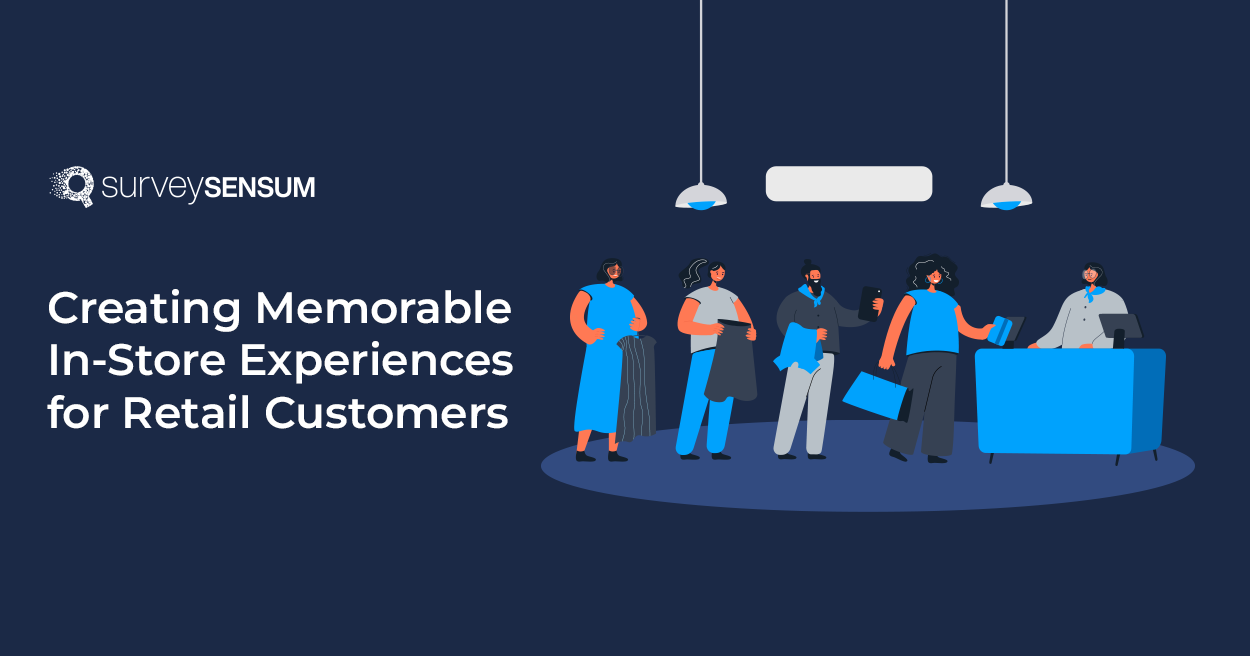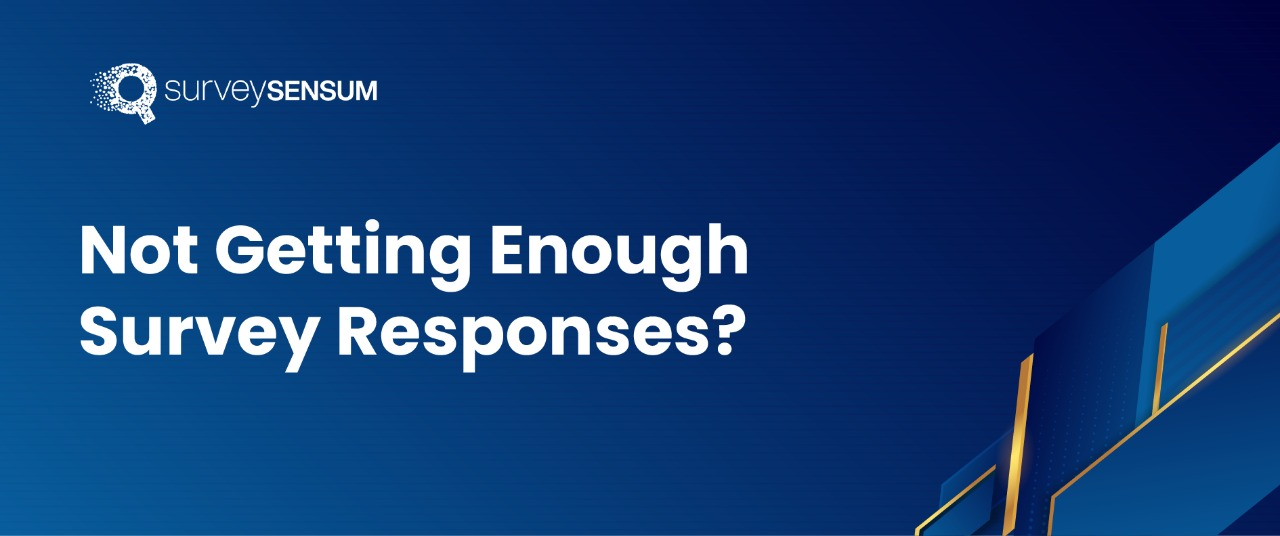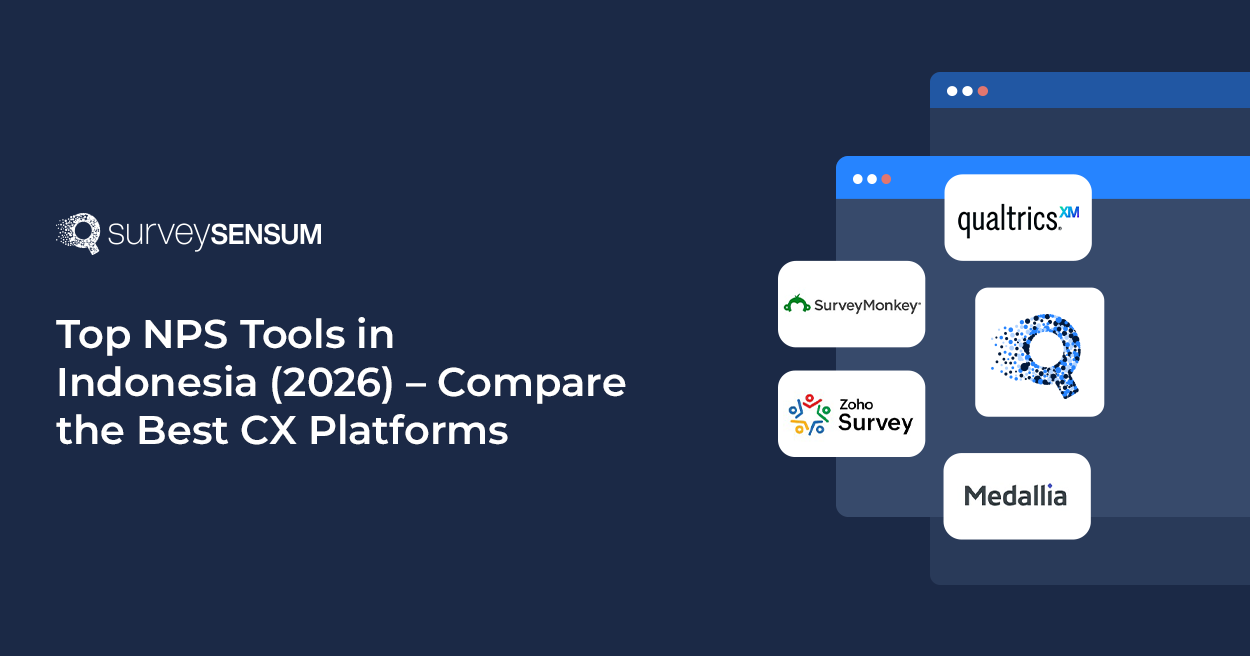

Due to COVID-19 our shopping behavior and preferences did change, significantly impacting the retail customer experience. We began shopping online more than opting for in-store experiences because it was considered safer at that time. However, over time, it also became a matter of convenience. Consequently, online shopping has gained even more popularity.
But is it still the same?
A notable number of respondents allocated a significant part of their shopping budget to physical stores, indicating a sustained interest in in-person shopping. Furthermore, a considerable portion expressed a preference for shopping at brick-and-mortar stores. This underscores the evolving nature of customer shopping habits, emphasizing the role of both online platforms and the retail customer experience. Also, it gives a chance for brands to enhance their physical stores and nurture customer loyalty.
But how?
Given below are 6 touchpoints you can optimize at your stores along with leveraging the retail customer feedback platform to ensure a memorable shopping experience for your customers.
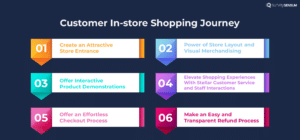
Optimizing Touchpoints for a Memorable In-store Experience
Customers go through many touchpoints when shopping in-store. These touchpoints can be store layout, staff behavior, checkout process, etc. If not paid attention to, these touchpoints may result in a negative in-store experience for the customer.
So, here is a list of 6 important touchpoints that you can optimize at your store for a memorable retail customer experience. This list also comes along with some of the best retail customer experience examples.
1. WOW Them with Your Store Entrance
What’s the first thing you look at when you visit any store?
The entrance, right?
That is how you recognize the store you want to visit.
Let’s say the entrance of the store that you want to visit is not properly lit, the brand logo is half broken, and there is garbage lying around, would you still go inside? Probably not.
That’s why first impressions matter the most. Your store’s entrance is the first point of contact between you and your customer so it is important to create a visually appealing entrance that represents your brand properly and attracts your customers.
You can do this by simply:
- Incorporating eye-catching signage, and lighting
- Placing appropriate mannequins to create a visually appealing display of your products
- Keeping the area near your store clean
- Having staff great your customer at the gate.
Brand Example: The jewelry brand, Swarovski, is known for its elegant and dazzling store entrances that showcase its exquisite crystal jewelry like rings and accessories. The store’s entrances are always brightly lit, like diamonds, to reflect its brand identity and attract customers.
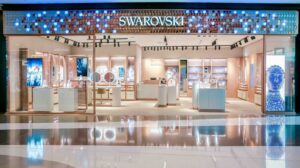
| Improve your store entrance by using your customer’s feedback. | |
| Touchpoint | Store Entrance |
| Type of Survey | First Impressions Survey |
| When to Send | Immediately or after their visit |
| Suggested Platforms | Online surveys, in-store tablets, or kiosks |
| Examples of some questions to include in the survey |
|
2. Give them what they are looking for in ONE GO: Power of Better Store Layout and Visual Merchandising
As human beings, we all want order in life. A proper path or direction to follow for achieving our goals.
The same goes for retail stores like Tissot Seastar. While shopping the frustrating part is getting lost and confused. A marked path or proper direction to shop is an important factor that helps shoppers navigate through the store while having a pleasant shopping experience.
This is why it is essential to give store layout and visual merchandising importance when you are trying to improve the in-store experience for your customers.
You need to make sure that when a customer enters your store they can easily navigate through your stores and have a seamless shopping experience. When a customer can easily find what they are looking for, it enhances their shopping experience and reduces frustration.
You can create a well-organized store layout for your retail store by following these tips:
- Proper placements of signage: Place proper and clear signage at different places to guide customers to different sections, departments, and promotional areas.
- Clear pathways: It goes without saying that the pathways of your store should be clutter-free.
- Thoughtful Product Placement: Strategically place your products based on categories and logical groupings.
But more than ensuring a well-organized store layout is required, you also need to do some visual merchandising.
What does that mean?
Well, visual merchandising refers to the strategic arrangement and presentation of products in a visually appealing manner. This aims to attract customers’ attention, highlight key products, and create an immersive and engaging shopping experience. With the right and the best AI for presentations, you can make this possible and demonstrate your products or services in the best light.
Here are some effective visual merchandising techniques:
- Window displays: Create attractive window displays by using creative props, and signages to capture the attention of passersby and entice them to enter your store.
- Product Grouping: Arrange complementary products together to encourage cross-selling and inspire customers to explore related items.
- Interactive Displays: Incorporate interactive elements into displays like VR experiences to encourage customers to engage with the products.
Brand example: IKEA is known for its large warehouse-like retail stores with a variety of products for home improvement. But how does IKEA plan the layout and product placement for such a large store?
When you enter IKEA you will notice a clear fixed path is designed that all customers must follow. This approach ensures that you stay in the store longer and get exposed to more products.
And the products are placed categorically and in a proper color sequence to make them visually appealing, and the path is clearly marked with visible signages. This enhances the shopping experience of customers and sometimes they start making impulsive purchases based on their emotions rather than their logic.
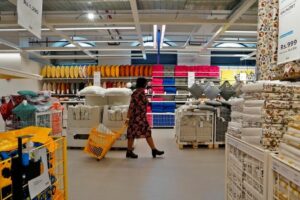
| Improve your store layout and visual merchandising by using your customer’s feedback. | |
| Touchpoint | Store Layout and Visual Merchandising |
| Type of Survey | Store Experience Survey |
| When to Send | End of their visit or shortly after |
| Suggested Platforms | Online surveys, in-store tablets, or kiosks |
| Examples of some questions to include in the survey |
|
3. Offer Interactive Product Demonstrations
According to Research by the International Council of Shopping Centers (ICSC), 73% of consumers want to try on touch the product before purchasing.
Imagine visiting two popular stores in search of a stylish office bag. Store A boasts a neat setup, courteous staff, and high-quality products. However, they restrict you from touching or experiencing a demonstration of the bag’s features.
In contrast, Store B goes above and beyond by providing excellent service. They allow you to hold the bag, assess how it suits you, and even demonstrate its numerous chains, compartments, and weight capacity.
Now, which store would you choose? Store A or Store B?
Store B, right?
But why? Because even if the bag at Store A appears more premium, the inability to touch or receive a demonstration created doubts in your mind. In contrast, Store B’s interactive demonstration helped you to make an informed decision.
One of the most effective ways to capture your customer’s attention and encourage them to interact with your brand is through engaging displays and demonstrations. By showcasing products in an interactive manner, you can provide customers with a hands-on experience that allows them to touch, try, or test the products.
Here are some tips with which you can achieve to improve in-store experience:
- Create designated sample stations: Providing testers or samples allows customers to experience the product which can influence their purchasing decisions positively.
- Live demonstrations: You can leverage the power of social media and plan live demonstrations at specific times to create anticipation and draw customers’ attention.
- Technology Integration: Incorporate technology into your shopping experience, such as interactive displays, to provide additional information or VR experiences.
| Improve your product displays and demonstrations by using your customer’s feedback. | |
| Touchpoint | Product Displays and Demonstrations |
| Type of Survey | Interactive Experience Survey |
| When to Send | End of their visit or shortly after |
| Suggested Platforms | Online surveys, in-store tablets or kiosks |
| Examples of some questions to include in the survey |
|
4. Elevate Shopping Experiences With Stellar Customer Service and Staff Interactions
According to the ‘State of the In-Store Experience 2021’ by Radiyant, 31.5% of the respondents stated that the quality of customer service is the most important for them when it comes to shopping in-store.
Your customer service staff are the first point of contact for any customer that comes to your store. So, provide your staff with proper training and knowledge about your product so that they can assist customers with any queries and can give proper demonstrations of your products.
Also, train your staff to be helpful and friendly towards your customers. This will leave a positive impression on your customers.
| Improve your customer service and staff interactions by using your customer’s feedback. | |
| Touchpoint | Customer Service and Staff Interactions |
| Type of Survey | Customer Service Feedback Survey |
| When to Send | Immediately after an interaction or after a visit |
| Suggested Platforms | Online surveys, in-store tablets, or kiosks |
| Examples of some questions to include in the survey |
|
Create Customer Service Feedback Surveys With SurveySensum – Request a Demo
5. Offer An Effortless Checkout Process
Imagine this: You went to buy some T-shirts. You collect your T-shirts and head over to the checkout counter. The store isn’t crowded but the line at the counter is long. Turns out, out of four checkout counters three are down and the one that is working is understaffed. Also, the card swipe machine is facing some trouble.
At this point, the queue just keeps getting longer. After waiting for 40 minutes it is finally your turn to pay for your T-shirts. Do you think you will visit this store again? Maybe if they have a huge discount, right?
A seamless and efficient checkout process is essential for a positive in-store experience. Long waiting times or complicated payment processes can easily lead to frustration and dissatisfaction among customers.
And, according to the ‘Smart Stores Report’ by Capgemini, 60% of customers stated that long queues at the checkout counter are the major pain point while shopping in-store.
You can ensure a smooth checkout process for your customers by:
- Installing more checkout counters so that queues will be short
- Offering multiple payment options, like a credit card, debit card, and digital payment options.
- Automating the checkout process by installing self-checkout kiosks
- Placing a sufficient number of staff to fasten the checkout and packaging process
Brand example: The brand that is winning at this is Decathlon. Decathlon introduced a hassle-free shopping experience by installing self-checkout counters equipped with a scan and pay app for billing. This allows customers to scan and pay for their purchases using their smartphones which automatically disables their RFID security tag.
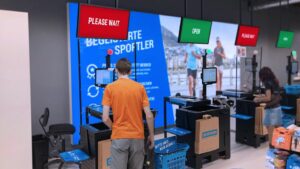
| Improve your checkout process by using your customer’s feedback. | |
| Touchpoint | Checkout Process |
| Type of Survey | Checkout Experience Survey |
| When to Send | Immediately after completing purchase |
| Suggested Platforms | Online surveys, in-store tablets, or kiosks |
| Examples of some questions to include in the survey |
|
6. Make an Easy and Transparent Refund Process to improve in-store experience
A customer-friendly and hassle-free refund process is essential for maintaining customer trust and satisfaction. This is especially relevant in jewelry stores where customers may choose to return items or sell gold for instant liquidity. Having a transparent process ensures long-term loyalty. It is important to ensure that you and your staff maintain clear communication and transparency when it comes to policies and procedures related to the return process.
Here are some strategies you can include to create a customer-friendly refund process for your store:
- Clear communication and easy-to-understand guidelines: Ensure that refund policies and procedures are clearly communicated to customers.
- Dedicated Refund Counter: Designate a specific area or counter in the store where customers can go to process their refunds.
- Instant Refunds: Consider offering instant refunds for eligible items.
Brand example: Marks and Spencer offer a transparent and seamless refund process. They offer a return on all purchases with a “no questions asked” refund and return policy. Once the item is processed the amount is returned to the account with which you made the payment, resulting in a hassle-free refund process.
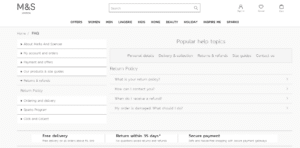
| Improve your refund process by using your customer’s feedback. | |
| Touchpoint | Refund Process |
| Type of Survey | Refund Experience Survey |
| When to Send | After a customer completes the refund process |
| Suggested Platforms | Online surveys, in-store tablets or kiosks |
| Examples of some questions to include in the survey |
|
Optimizing the important touchpoints of your customer’s shopping journey is important but not enough. You also need to incorporate some practices to improve your in-store experiences.
Design Refund Experience Feedback Surveys With SurveySensum – Request a Demo
Best Practices to Improve In-Store Experiences
Here are 4 best practices to follow to improve your in-store experiences.
1. Personalization
Who doesn’t like personalization?
Whether it is a phone cover, canvas photo prints & wall art or a pendant with the initials of our name, everyone wants to have products that are unique and customized for them. That’s the universal truth.
The same goes for your in-store experiences.
According to the Using Retail Personalization to Connect with Customers Report’ by Salesforce it was found that 57% of customers said that they are willing to share personal information with brands in exchange for personalized offers and discounts and 62% said that it is acceptable for brands to send personalized offers or discounts based on the items they have purchased.
The above statistics show customers’ preferences and expectations. Customers expect brands to create personalized experiences for them through messages, offers, or discounts. Here are a few tips that you can use to personalize your customer’s in-store experience.
- Customer Recognition: Train your staff to personalize interactions by using customer names and remembering their previous purchases or preferences.
- Tailored Recommendations: You have information on customers’ purchase data, and leverage it to offer personalized product recommendations.
- Loyalty Programs: Implement loyalty programs that reward customers for their continued support.
2. Technology Integration
With the integration of technology like self-checkout counters, smart fitting rooms, etc, you can give your store a futuristic look and make your customer’s in-store experiences unique and engaging.
According to the Global Consumer Insights Pulse Survey by PwC, 30% of customers said they would be attracted to physical stores for immersive digital experiences such as donning a virtual reality (VR) headset to try out new products.
While 16% of the customers said the ability to use self-service checkout kiosks was their most-favored attribute for their in-store experience and 12% would like “scan and go” devices and apps at checkout counters.
And these numbers will only keep increasing in the near future.
You can leverage the power of technology for improving your in-store experience by:
- Installing self-checkout counters for a faster checkout process.
- Developing mobile apps that provide customers with personalized offers, product information, and an interactive shopping experience.
- Smart fitting rooms to help customers get a better idea of how the particular item will look on them without even trying it out.
- Using AR and VR to give your customers an immersive shopping experience.
Brand Example: Amazon Fresh Store – which was launched in the USA in 2020 features the Amazon dash cart lane. You simply take the cart and put your items into it. The cart has a scanner that will be scanning your items and add them to your Amazon account.
Once done, just pack everything and exit the store and the bill will be added to your Amazon account. Completely cashless and hassle-free shopping experience.
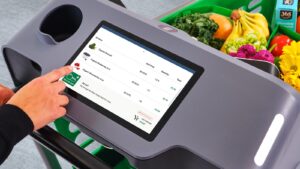
3. Events and Experiential Marketing
Hosting in-store events, workshops, or demonstrations create memorable experiences that go beyond traditional shopping. These events will help you in creating a feeling of community and friendship between you and your customers. And also among the customers.
Many famous brands like Benefit Cosmetics, Sephora, Lulumelon, and M&M have created events from time to time. Brands do this for reasons; to introduce new products, engage customers with the stores, boost revenue, etc.
For example, to create a buzz for the highly anticipated release of “Gilmore Girls: A Year in the Life,” the Netflix team generated hype and enthusiasm by setting up 200 temporary Luke’s Diners, a diner in the show, across the nation.
These pop-up locations offered free coffee to fans, resulting in tremendous success. Each site experienced long queues of eager attendees, and the event generated significant social media activity, including the Snapchat filter associated with the event being viewed a staggering 880,000 times.
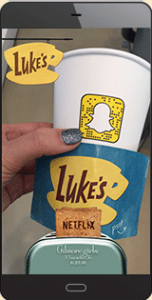
4. Measuring and Adapting
After implementing strategies to improve in-store experiences the next course of action is to gather feedback, make data-driven decisions, and analyze what is working and what is not.
This is needed to continuously improve the in-store experiences for your customers because this is not a one-time thing; it is an ongoing process.
Here’s how to measure and adapt:
Step 1: Customer Surveys
Implement customer surveys (CSAT or NPS) to gather valuable feedback on satisfaction levels, preferences, and areas for improvement. Send surveys at different stages of the shopping journey, such as immediately after store visits, to assess staff satisfaction, checkout process, and overall experience.
Step 2: Analyze feedback and behavior to identify areas for improvement
Analyze collected feedback and customer behavior data to identify recurring patterns and trends, and highlight areas that require attention in real-time with tools like text analysis. Utilize this data to make informed decisions about store layout, product placement, staffing requirements, and checkout counters.
A retail customer feedback platform like SurveySensum can help you launch customer surveys, identify touchpoints causing friction, understand reasons behind the friction through text analysis, and track CSAT scores in real-time with customized dashboards.
Step 3: Continuous iteration and refining strategies based on data-driven insights
Improving in-store experiences is an ongoing process that requires repeatedly measuring, adapting, and iterating. By continuously gathering feedback, analyzing data, refining strategies, and implementing changes, businesses can stay responsive to evolving customer needs and preferences, ensuring better results over time.
It is not a one-time effort but a continual commitment to enhancing the customer experience.
Conclusion
The relevance of in-store shopping is not all gone, rather it is here to stay. So, improving the in-store shopping experience for customers is as important as the online shopping experience.
Creating memorable in-store experiences for retail customers goes beyond product availability and competitive pricing. There are many touchpoints that brands tend to ignore but they matter a lot when it comes to a pleasant customer experience.
By optimizing touchpoints such as engaging product displays and demonstrations, proper store layout, exceptional customer service and staff interactions, a seamless checkout process, and a customer-friendly refund process, brands can leave a lasting impression on customers.
Not only that, brands also need to listen to customer feedback through surveys and continuously improve these touchpoints to build strong customer relationships and foster customer loyalty in an increasingly competitive market.






